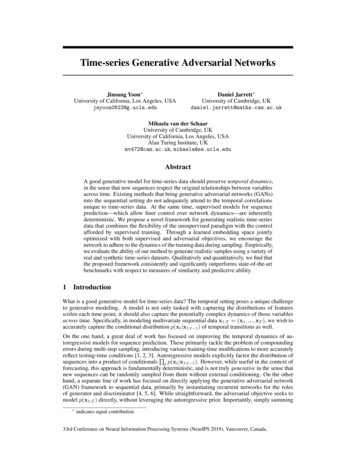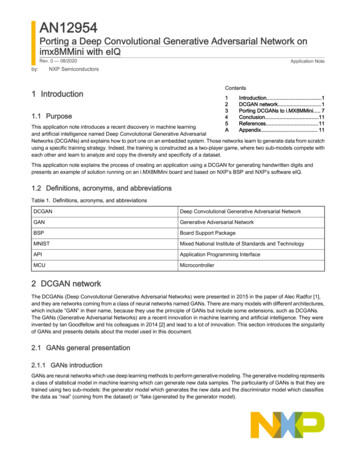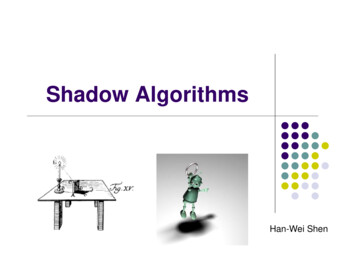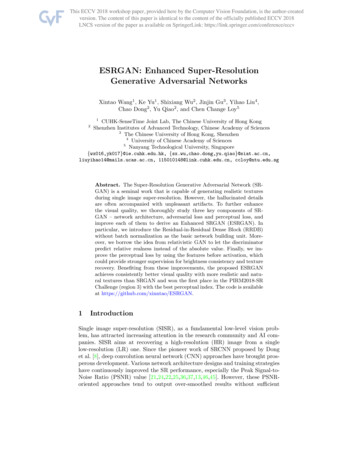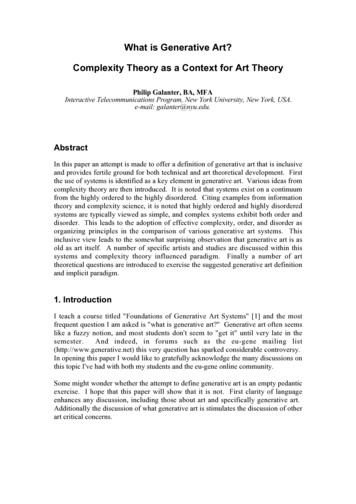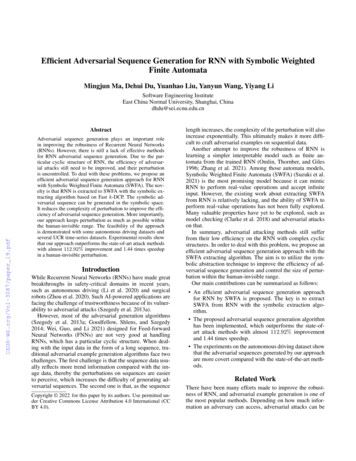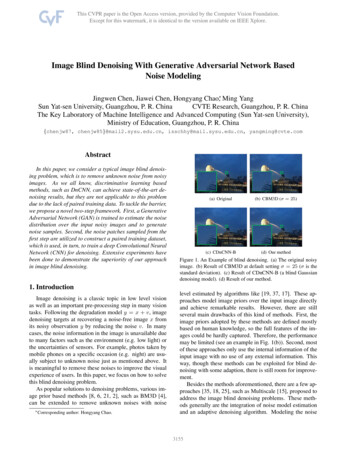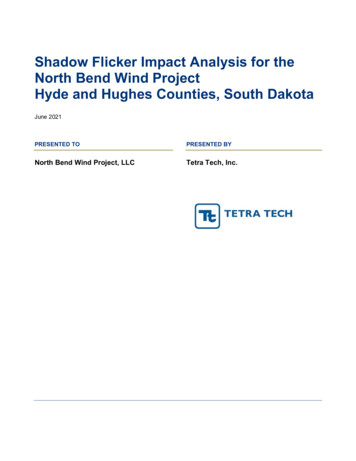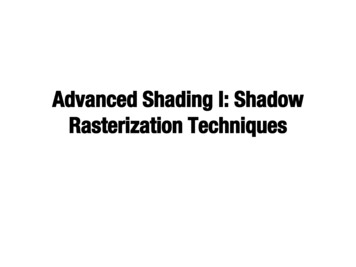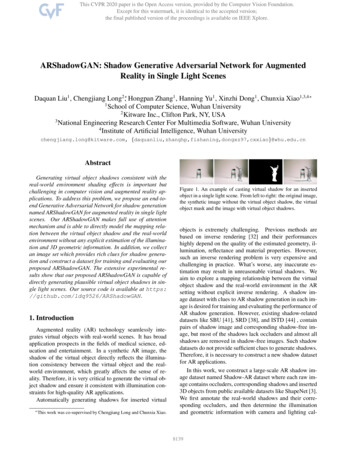
Transcription
ARShadowGAN: Shadow Generative Adversarial Network for AugmentedReality in Single Light ScenesDaquan Liu1 , Chengjiang Long2 , Hongpan Zhang1 , Hanning Yu1 , Xinzhi Dong1 , Chunxia Xiao1,3,4 1School of Computer Science, Wuhan University2Kitware Inc., Clifton Park, NY, USA3National Engineering Research Center For Multimedia Software, Wuhan University4Institute of Artificial Intelligence, Wuhan Universitychengjiang.long@kitware.com, edu.cnAbstractGenerating virtual object shadows consistent with thereal-world environment shading effects is important butchallenging in computer vision and augmented reality applications. To address this problem, we propose an end-toend Generative Adversarial Network for shadow generationnamed ARShadowGAN for augmented reality in single lightscenes. Our ARShadowGAN makes full use of attentionmechanism and is able to directly model the mapping relation between the virtual object shadow and the real-worldenvironment without any explicit estimation of the illumination and 3D geometric information. In addition, we collectan image set which provides rich clues for shadow generation and construct a dataset for training and evaluating ourproposed ARShadowGAN. The extensive experimental results show that our proposed ARShadowGAN is capable ofdirectly generating plausible virtual object shadows in single light scenes. Our source code is available at https://github.com/ldq9526/ARShadowGAN .1. IntroductionAugmented reality (AR) technology seamlessly integrates virtual objects with real-world scenes. It has broadapplication prospects in the fields of medical science, education and entertainment. In a synthetic AR image, theshadow of the virtual object directly reflects the illumination consistency between the virtual object and the realworld environment, which greatly affects the sense of reality. Therefore, it is very critical to generate the virtual object shadow and ensure it consistent with illumination constraints for high-quality AR applications.Automatically generating shadows for inserted virtual Thiswork was co-supervised by Chengjiang Long and Chunxia Xiao.Figure 1. An example of casting virtual shadow for an insertedobject in a single light scene. From left to right: the original image,the synthetic image without the virtual object shadow, the virtualobject mask and the image with virtual object shadows.objects is extremely challenging. Previous methods arebased on inverse rendering [32] and their performanceshighly depend on the quality of the estimated geometry, illumination, reflectance and material properties. However,such an inverse rendering problem is very expensive andchallenging in practice. What’s worse, any inaccurate estimation may result in unreasonable virtual shadows. Weaim to explore a mapping relationship between the virtualobject shadow and the real-world environment in the ARsetting without explicit inverse rendering. A shadow image dataset with clues to AR shadow generation in each image is desired for training and evaluating the performance ofAR shadow generation. However, existing shadow-relateddatasets like SBU [41], SRD [38], and ISTD [44] , containpairs of shadow image and corresponding shadow-free image, but most of the shadows lack occluders and almost allshadows are removed in shadow-free images. Such shadowdatasets do not provide sufficient clues to generate shadows.Therefore, it is necessary to construct a new shadow datasetfor AR applications.In this work, we construct a large-scale AR shadow image dataset named Shadow-AR dataset where each raw image contains occluders, corresponding shadows and inserted3D objects from public available datasets like ShapeNet [3].We first annotate the real-world shadows and their corresponding occluders, and then determine the illuminationand geometric information with camera and lighting cal-8139
ibration. Then we can apply 3D rendering to produceshadow for an inserted 3D object and take it as the groundtruth virtual shadow for both training and evaluation.We observe that a straightforward solution like an imageto-image translation network cannot achieve plausible virtual shadows since it does not pay sufficient attention forhandling the more important regions like real-world shadows and corresponding occluders. This observation inspires us to leverage the spatial attention information forreal-world shadows and corresponding occluders to generate shadows for inserted virtual objects.In this paper, we propose a generative adversarial network for directly virtual object shadow generation, whichis called ARShadowGAN. As illustrated in Figure 1, ARShadowGAN takes a synthetic AR image without virtualshadows and the virtual object mask as input, and directlygenerates plausible virtual object shadows to make the ARimage more realistic. Unlike inverse rendering-based methods [22, 23] perform geometry, illumination and reflectanceestimation, our proposed ARShadowGAN produces virtualshadows without any explicit inverse rendering. Our keyinsight is to model the mapping relationship between thevirtual object shadow and the real-world environment. Inother words, ARShadowGAN automatically infers virtualobject shadows with the clues provided by the real-worldenvironment.We shall emphasize that we adopt the adversarial training process [10] between the generator and the discriminator to generate an AR shadow image. With the numberof epoches increases, both models improve their functionalities so that it becomes harder and harder to distinguish agenerated AR shadow image from a real AR shadow image.Therefore, after a certain large number of training epochs,we can utilize the learned parameters in the generator togenerate an AR shadow image.To sum up, our main contributions are three-fold: We construct the first large-scale Shadow-AR dataset,which consists of 3,000 quintuples and each quintupleconsists of a synthetic AR image without the virtualobject shadow and its corresponding AR image containing the virtual object shadow, a mask of the virtual object, a labeled real-world shadow matting andits corresponding labeled occluder. We propose an end-to-end trainable generative adversarial network named ARShadowGAN. It is capableof directly generating virtual object shadows withoutillumination and geometry estimation. Through extensive experiments, we show that the proposed ARShadowGAN outperforms the baselines derived from state-of-the-art straightforward image-toimage translation solutions.2. Related WorkThe related work to shadow generation can be dividedinto two categories: with or without inverse rendering.Shadow Generation with Inverse Rendering. Previousmethods are based on inverse rendering to generate virtualobject shadows, which require geometry, illumination, reflectance and material properties. Methods [39, 36, 48, 1]estimate lighting with known marker, which fail when themarker is blocked. Methods [22, 23, 25] estimate all therequired properties, but inaccurate reconstruction results inodd-looking results. In recent years, deep learning hasmade significant breakthroughs, especially in visual recognition [13, 18, 26, 28, 17, 30, 27, 29, 16], object detection and segmentation [9, 42, 31], and so on. In particular, deep learning-based methods [7, 45, 8, 6, 14, 49] havebeen developed to estimate HDR illumination from a singleLDR image but few of them work well for both indoor andoutdoor scenes, and the rendering requires user interaction.Such heavy time and labor cost make this kind of methodsinfeasible for automatic shadow generation in AR.Shadow Generation without Inverse Rendering. Inrecent years, generative adversarial network (GAN) [10]and its variants such as cGAN [33] and WGAN [2] haveproven been applied successfully to various generative taskssuch as shadow detection and removal [44, 46, 5, 50], ofcourse also can be extended for shadow generation as aparticular style transfer. It is worth mentioning that Huet al.’s Mask-ShadowGAN [15] conducts shadow removaland mask-guided shadow generation with unpaired data atthe same time. Zhang et al. extended image completioncGAN [19] to ShadowGAN [51] which generates virtualobject shadows for VR images in which the scenes are synthesized with a single point light. Nonetheless, these methods dose not account for the occluders of real shadows. Unlike the previous methods, our proposed ARShadowGANmakes full use of spatial attention mechanism to explore thecorrelation between occluders and the corresponding shadows to cast plausible virtual shadows for inserted objects.3. Shadow-AR DatasetTo cast shadow for an inserted virtual object in a single light scene, we need to explore a mapping relationshipbetween the virtual object and the shadow in the AR setting. A necessary shadow image dataset with shadow cluesfor generating virtual shadow in each image is desired fortraining and evaluating the performance of virtual shadowgeneration. However, existing shadow-related datasets havemany limitations. SBU [41] and UCF [52] consist of pairsof shadow images and corresponding shadow masks but nocorresponding shadow-free images. SRD [38], UIUC [12],LRSS [11] and ISTD [44] contain pairs of shadow image and corresponding shadow-free image, but most of the8140
(a)(b)(c)(d)(e)(f)Figure 2. An illustration of two image examples in our Shadow-AR dataset. (a) is the original scene image without marker, (b) is thesynthetic image without virtual object shadow, (c) is the mask of the virtual object, (d) is the real-world occluder, (e) is the real-worldshadow, and (f) is the synthetic image containing the virtual object shadow.shows examples of our image data.3.2. Mask Annotation and Shadow RenderingLight SourceMCameraFigure 3. An illustration of data annotation. A 3D Cartesian coordinate system M is established at the square marker. The camerapose is calculated by marker recognition. The light source positionor direction is calibrated in the coordinate system M.shadows lack occluders and almost all shadows are removedin shadow-free images. Such shadow datasets do not provide sufficient clues to generate shadows. Therefore, wehave to construct a Shadow-AR dataset with shadow imagesand virtual objects.3.1. Data CollectionWe collect raw images taken with a Logitech C920 Camera at 640 480 resolution, where scenes are taken with different camera poses. We keep real-world shadows and thecorresponding occluders in photos because we believe thatthese can be used as series clues to shadow inference. Wechoose 9 models from ShapeNet [3], 4 models from Stanford 3D scanning repository and insert them into photos toproduce different images of foreground (model) and background (scene) combinations. Our Shadow-AR dataset contains 3,000 quintuples. Each quintuple consists of 5 images:a synthetic image without the virtual object shadow and itscorresponding image containing the virtual object shadow,a mask of the virtual object, a labeled real-world shadowmatting and its corresponding labeled occluder. Figure 2We need to collect supervised information containingthe real-world shadow matting, the corresponding occludermask, and the synthetic images with plausible virtual object shadows. Note that insertion of a virtual 3D object requires geometric consistency and the virtual object shadowneeds to be consistent with the real-world environment.This means that we need to calibrate the camera pose andthe lighting in the real-world environment at the same time,which is very challenging. For convenience, we use a simple black-white square marker to complete the data annotation. As is shown in Figure 3, we establish such a 3DCartesian coordinate system M at the square marker asthe world coordinate system.Clues annotation. As is shown in Figure 2.(c)-(d),we annotate the real-world shadows and their corresponding occluders, which help to inference the virtual objectshadow. We annotate real-world shadows with RobustMatting software and annotate occluder with the LabelMetool [43].Camera and lighting calibration. We perform thesquare marker recognition and tracking by adaptive threshold with Otsu’s [35] segmentation. With the extractedfour marker corner points, camera poses are calculated byEPnP [24]. For indoor scenes, we consider a single dominant light and model it as a point light source with a threedimensional position. To determine the most dominant lightsource, we manually block or turn off each indoor light(usually point or area light) sequentially and choose the onegives the most visible shadow. Then, we manually measure the dominant light geometric center coordinate Xm asthe light position (as is shown in Figure 3). For outdoorscenes, the main light source is the sun and we model it asa directional light source. We measure the sunlight direction using interest point correspondences between a known8141
block, a virtual shadow generator with a refinement module,and a discriminator to distinguish whether the generated virtual shadow is plausible.4.1. Attention Block(a) occluder area distribution(b) real-world shadow area distribution(c) virtual object area distribution(d) virtual object location distributionFigure 4. Statistics of virtual objects and real-world clues. Weshow that our dataset have reasonable property distributions.straight edge and its shadow.Rendering. With the calibrated camera and lighting, werender 3D objects and the corresponding shadows. We render 3D objects with Phong shading [37]. We experimentally set ambient lighting as white with normalized intensity0.25 for indoor and 0.35 for outdoor. We add a plane at thebottom of the 3D object and perform shadow mapping [47]along with alpha blending to produce shadows. To make thegenerated shadows have consistent appearances with realworld shadows, we apply a Gaussian kernel (5 5, σ 1.0)to blur the shadow boundaries to get soft shadow borders.Figure 4 shows statistical analysis of distribution properties of our dataset. The area distribution is expressed asthe ratio between the target (shadows, occluders or virtualobjects) area and image area. As we can see, majority of occluders falls in range of (0.0, 0.3], majority of shadows fallsin range of (0.0, 0.2] and majority of virtual objects falls inrange of (0.0, 0.2]. We found that clues falling in (0.4, 0.6]occupy most of the image area, making it difficult to insertvirtual objects. Similarly, inserted objects with too largearea will block important clues. There are almost no suchcases in our data set. In addition, we analyze the spatial distribution of virtual objects, we compute a probability map(Figure 4 (d)) to show how likely a pixel belongs to a virtualobject. This is reasonable as virtual objects placed aroundhuman eyesight usually produce the most visual pleasingresults.4. Proposed ARShadowGANAs illustrated in Figure 5, our proposed ARShadowGANis an end-to-end network which takes a synthetic imagewithout virtual object shadows and the virtual object maskas input, and produces the corresponding image with virtualobject shadows. It consists of 3 components: an attentionThe attention block produces attention maps of realshadows and corresponding occluders. The attention mapis a matrix with elements ranging from 0 to 1 which indicates varying attention of the real-world environments. Theattention block takes the concatenation of the image without virtual object shadows and the virtual object mask asinput. It has two identical decoder branches and one branchpredicts the real shadow attention map and the other onepredicts the corresponding ocluder attention map.There are 4 down-sampling (DS) layers. Each DS layerextracts features by a residual block [13] which consists of3 consecutive convolution, batch normalization and LeakyReLU operations and halves the feature map with an average pooling operation. Then, features extracted by DS layers are shared by two decoder branches. The two decoderbranches have the same architecture. Each decoder consistsof 4 up-sampling (US) layers. Each US layer doubles thefeature map by nearest interpolation followed by consecutive dilated convolution, batch normalization and LeakyReLU operations. The last feature map is activated by asigmoid function. Symmetrical DS-US layers are concatenated by skip connections.4.2. Virtual Shadow GeneratorThe virtual shadow generator produces plausible virtualobject shadows. It consists of a U-net followed by a refinement module. The U-net with 5 DS-US layers produces acoarse residual shadow image and then it is fine-tuned bythe refinement module with 4 consecutive composite functions [18]. The final output is the addition of the improvedresidual shadow image and the input image.In the virtual shadow generator, DS layers are the sameas those in the attention block while US layers use convolutions instead of dilated ones. Each composite functionproduces 64 feature maps.4.3. DiscriminatorThe discriminator distinguishes whether the virtualshadow shadows are plausible, thereby assisting the training of generator. We designed the discriminator in the formof Patch-GAN [20].The discriminator contains 4 consecutive convolutionwith valid padding, instance normalization and LeakyReLU operations. Then, a convolution produces the lastfeature map which is activated by sigmoid function. Thefinal output of the discriminator is the global average pooling of the activated last feature map. In ARShadowGAN,the discriminator takes the concatenation of image without8142
rShadowDecoder Netblock32x32x512Discriminator concatenation additionReal/Fake16x16x512 ImageEncoder vShadowDecoderRefinement Figure 5. The architecture of our proposed ARShadowGAN. It consists of an attention block, a virtual shadow generator with a refinementmodule and a discriminator. Attention block has two branches producing attention maps of real-world shadows and occluders. The attentionmaps are leveraged by virtual shadow generator to produce a coarse residual shadow image. The coarse shadow image is fine-tuned by therefinement module. The final output is the addition of input image and the fine-tuned residual shadow image.virtual object shadows, virtual object masks and the imagewith virtual object shadows as input.ŷ x R(G(x, m, Arobj , Arshadow )) through the refinement module R(·). Therefore, we can define L2 as follows:4.4. Loss functionsL2 ky ȳk22 ky ŷk22 ,Attention Loss. We use standard squared loss to measure the difference between the predicted attention mapsand the ground truth masks. Lattn is defined as follows:Lattn kArobj (x, m) Mrobj k22 kArshadow (x, m) Mrshadow k22 ,(1)where Arshadow (·) is the output attention map for real shadows and Arobj (·) is the output attention map for real objects based on the input synthetic image x without virtualobject shadows and the virtual object mask m. Note bothMrobj and Mrshadow are the ground truth binary maps ofthe real-world shadows and their corresponding occluders.For Mrobj , 1 indicates that the pixel belongs to real objectsand 0 otherwise. Similarly, 1 in Mrshadow indicates thepixel in the real shadow regions and 0 not.Shadow Generation Loss. Lgen is used to measure thedifference between the ground truth and the generated image with virtual object shadows. The shadow generationloss consists of three weighted terms, i.e., L2 , Lper andLadv , and the total loss is:Lgen β1 L2 β2 Lper β3 Ladv ,(2)where β1 , β2 and β3 are hyper-parameters which control theinfluence of terms.L2 is the pixel-wise loss between the generated image and the corresponding ground truth. It is worth mentioning that our ARShadowGAN produces a coarse residual shadow image to generate a coarse virtual shadow image ȳ x G(x, m, Arobj , Arshadow ). We further improve the residual image to form the final shadow image(3)where y is the corresponding ground truth shadow image.Lper is the perceptual loss [21], which measures thesemantic difference between the generated image and theground truth. We use a VGG16 model [40] pre-trained onImageNet dataset [4] to extract feature. The feature is theoutput of the 4th max pooling layer (14 14 512), i.e.the first 10 VGG16 layers are used to compute feature map.Lper is defined as follows:Lper MSE(Vy , Vȳ ) MSE(Vy , Vŷ ),(4)where MSE is the mean squared error, and Vi VGG(i)is the feature map extracted by the well-trained VGG16model.Ladv describes the competition between the generatorand the discriminator, which is defined as follows:Ladv log(D(x, m, y)) log(1 D(x, m, ŷ)),(5)where D(·) is the probability that the image is “real”. During the adversarial training, the discriminator tries to maximize Ladv while the generator tries to minimize it.4.5. Implementation detailsOur ARShadowGAN is implemented in TensorFlowframework. In ARShadowGAN, all the batch normalizationand Leaky ReLU operations share the same hyper parameters. We set decay as 0.9 for batch normalization and leak as0.2 for Leaky ReLU. All images in our dataset are resizedto 256 256 by cubic interpolation for training and testing.8143
Synthetic images and virtual object masks are normalized to[ 1, 1] while labeled clue images are normalized to [0, 1].We randomly divide our dataset into three parts: 500 for attention block training, 2,000 for virtual shadow generationtraining and 500 for testing.We adopt a two-stage training. At the 1st stage, we trainthe attention block alone with the 500 training set. We optimize the attention block by minimizing Lattn with ADAMoptimizer. Learning rate is initialized as 10 5 and β is setto (0.9, 0.99). The attention block is trained for 5000 iterations with batch size 1. At the 2nd stage, the attention blockis fixed and we train virtual shadow generator and the discriminator with the 2,000 training set. We set β1 10.0,β2 1.0, β3 0.01 for Lgen . We adopt ADAM optimizer to optimize the generator and discriminator. The optimizer parameters are all same as those in the 1st phase.The virtual shadow generator and discriminator is trainedfor 150,000 iterations with batch size 1. In each iteration,we alternately optimize the generator and discriminator.5. ExperimentsTo evaluate the performance of our proposed ARShadowGAN, we conduct experiments on our collected ShadowAR dataset. We calculate the average error on the testingset for quantitative evaluation. We calculate the root meansquare error (RMSE) and structural similarity index (SSIM)with generated shadow images and the ground truth to measure the global image error. We calculate the balanced errorrate [34] (BER) and accuracy (ACC) with generated shadowmasks and ground truth shadow masks, which are obtainedwith ratio threshold, to measure the shadow area and boundary error. In general, the smaller RMSE and BER, the largerSSIM and ACC, the better the generated image. Note thatall the images for visualization are resized to 4:3.5.1. Visualization of Generated AttentionsAttention maps are used to assist the virtual shadow generator. As is shown in Figure 6, real-world shadows andtheir corresponding occluders are suggested more attention.It is worth mentioning that the virtual object itself is not aclue, and the mask prevents the virtual object from receiving more attention as real-world shadows and occluders. Toverify the role of the mask, we replace the mask with a fullblack image which indicates no virtual object. The result isalso shown in the 2nd and 4th row of Figure 6.Figure 6. Examples of attention maps. From left to right: input images without virtual object shadows, input masks, attention mapsof real-world shadows and their corresponding occluders. Corresponding cases without masks are also shown.Pix2Pix [20] is a cGAN trained on paired data for general image-to-image translation. It is directly applicable toour shadow generation task. We make the Pix2Pix outputshadow image directly.Pix2Pix-Res is a variant of Pix2Pix whose architecture isthe same as Pix2Pix but outputs the residual virtual shadowimage like our ARShadowGAN.ShadowGAN [51] synthesizes shadows for inserted objects in VR images. ShadowGAN takes exactly the sameinput items as our ARShadowGAN and generates shadowmaps which are then multiplied to the source images to produce final images. We calculate shadow maps from our datato train ShadowGAN and we evaluate ShadowGAN withthe produced final images.Mask-ShadowGAN [15] performs both shadow removal and mask-guided shadow generation. We adapt thisframework to our task. Gs and Gf are two generators ofMask-ShadowGAN and we adjust Gs to perform virtualshadow generation while Gf to perform mask-guided virtual shadow removal.For fair comparison, we train all the models on the sametraining data with same training details and evaluate on thesame testing ANARShadowGAN5.2. Comparison to BaselinesTo our best knowledge, there are no existing methodsproposed to directly generate AR shadows for inserted object without any 3D information. We still choose the following methods as baselines to compete since we can extendand adapt them on the our 9610.9590.965S (%)41.46829.59728.34723.26122.278A (%)27.35826.47624.54721.13119.267ACC (%)90.63196.68997.12298.44398.453Table 1. Results of quantitative comparison. In the table, S represents BER of virtual shadow regions and A represents BER of thewhole shadow mask. The best scores are highlighted in bold.Quantitative comparison results are shown in Table 1.8144
(a)(b)(c)(d)(e)(f)(g)(h)Figure 7. Visualization comparison with different methods. From left to right are input image (a), input mask (b), the results of Pix2Pix(c), Pix2Pix-Res (d), ShadowGAN (e), Mask-ShadowGAN (f), ARShadowGAN (g), and ground-truth (h).(a) input image(b) input mask(d) w/o ℒ𝑎𝑑𝑣(c) w/o Attn(e) w/o Refine(f) ARShadowGAN(g) ground truthFigure 8. Examples of qualitative ablation studies of network modules.Examples of qualitative comparison are shown in Figure 7.As we can see, the overall performances of Pix2Pix-Res andShadowGAN are better than Pix2Pix, which indicates thatthe target of the shadow map or the residual shadow imagemakes the network focus on shadow itself rather than thewhole image reconstruction. Mask-ShadowGAN performsa little better than Pix2Pix-Res and ShadowGAN, but it stillproduces artifacts. ARShadowGAN outperforms baselineswith much less artifacts in terms of shadow azimuth andshape, which is partially because the attention mechanismenhances the beneficial features and make the most of them.Modelsw/o Attnw/o Refinew/o Ladvw/o Lperw/o M0.9620.9610.9590.9630.9240.965S (%)23.16223.08729.09329.57650.74822.278A (%)21.07921.02426.35426.39930.82919.267ACC (%)98.44698.45097.48797.15288.54898.453Table 2. Results of ablation studies. The best scores are highlighted in bold.5.3. Ablation StudiesTo verify the effectiveness of our loss function and network architecture, we compare our ARShadowGAN withits ablated versions: w/o Attn: we remove the attention block. w/o Refine: we remove the refinement module. w/o Ladv : we remove the discriminator (β3 0). w/o Lper : we remove Lper from Equation 2 (β2 0). w/o L2 : we remove L2 from Equation 2 (β1 0).For models without attention blocks, the input to the virtual shadow generator is adjust to the concatenation of synthetic image (without virtual object shadows) and the objectmask. We train these models on training set. Quantitativeresults of ablation studies are shown in Table 2 and examples of qualitative ablation studies are shown in Figure 8and Figure 9.Network modules. As we can see, our full modelachieves the best performance. As is shown in Figure 8,the model without a discriminator mostly produces oddlooking virtual object shadows because the generator hasnot yet converge, which indicates that adversarial training does speed up the convergence of the generator. Ourfull model outperforms the version without attention blockin overall virtual object shadow azimuth, which indicatesthat the attention block helps preserve features useful forshadow inference. The model without refinement moduleproduces artifacts in the shadow area, suggesting that therefinement module fine-tunes virtual shadows from detailsby nonlinear activation functions.Loss functions. As we can see, our full loss function achieves the best performance. As is shown in Figure 9, Lper has an important role in constraining the shadow8145
(a) input image(b) input mask(c) w/o ℒ2(d) w/o ℒ𝑝𝑒𝑟(e) ARShadowGAN(f) ground truthFigure 9. Examples of qualitative ablation studies of loss function.shape. However, Lper is a global semantic constraint ratherthan a detail, so the pixel-wise intensity and noise are notwell resolved. L2 maintains good pixel-wise intensity butproduces blurred virtual object shadows which are not goodin shape. Lper L2 outperforms both Lper and L2 , whichindicates that Lper and L2 promote each other.Figure 11. Failure cases of large dark areas and few clues. Fromleft to right: input images without virtual shadows, input masks,attention maps of real-world shadows and their corresponding occluder and output images.Figure 10. Robustness testing. From left to right: input images,input masks, attention maps of real-world shadows and their corresponding occluders and output images.5.4. Robustness TestingWe test our ARShadowGAN with new cases outsideShadow-AR dataset in Figure 10 to show the robustness.All the images, model buddha, vase and mug are new andwithout the ground truth. The case with the model insertedin the real shadow is shown in the 3rd row. Cases of multiple light sources and multiple inserted models are shown inthe 4th and 5th row. Visualization results shows that ARShadowGAN is capable of producing plausible shadows.6. LimitationsARShadowGAN is subject to the following limitations:(1) ARShadowGAN fails wh
Figure 2. An illustration of two image examples in our Shadow-AR dataset. (a) is the original scene image without marker, (b) is the synthetic image without virtual object shadow, (c) is the mask of the virtual object, (d) is the real-world occluder, (e) is the real-world shadow, and (f) is the synthetic image containing the virtual object .
